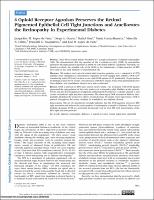δ opioid receptor agonism preserves the retinal pigmented epithelial cell tight junctions and ameliorates the retinopathy in experimental diabetes
Resum
Paraules clau
Retinopatia diabètica; Diabetis; Receptor opioide delta
Citació recomanada
Lopes de Faria JM, Duarte DA, Simó R, García-Ramirez M, Dátilo MN, Pasqualetto FC, et al. δ Opioid receptor agonism preserves the retinal pigmented epithelial cell tight junctions and ameliorates the retinopathy in experimental diabetes. Investig Ophthalmol Vis Sci. 2019 Sep 3;60(12):3842–53.
Audiència
Professionals
Empreu aquest identificador per citar i/o enllaçar aquest document
https://hdl.handle.net/11351/5057Aquest element apareix a les col·leccions següents
- VHIR - Articles científics [1200]
Els següents fitxers sobre la llicència estan associats a aquest element:


